Durham Miners' gala: Women's banner celebrates county's heroines
- Published
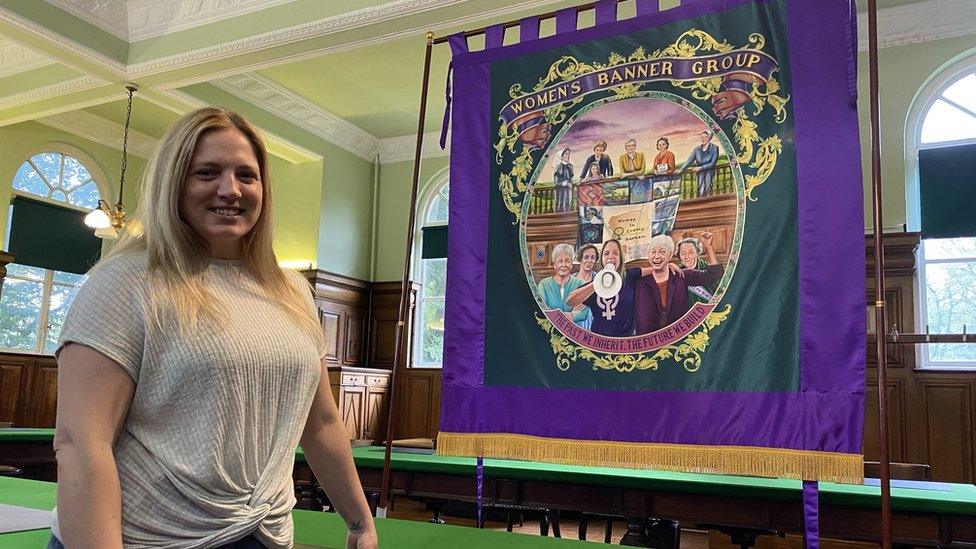
Laura Daly founded a group to create a banner celebrating County Durham's women
Banners celebrating the mines and miners of County Durham form a key part of the parade at the annual Durham Miners' Gala. Frustrated at the lack of women depicted, one group decided to create their own flag celebrating the region's heroines. Who has been put on Durham's newest banner?
The World War One nurse
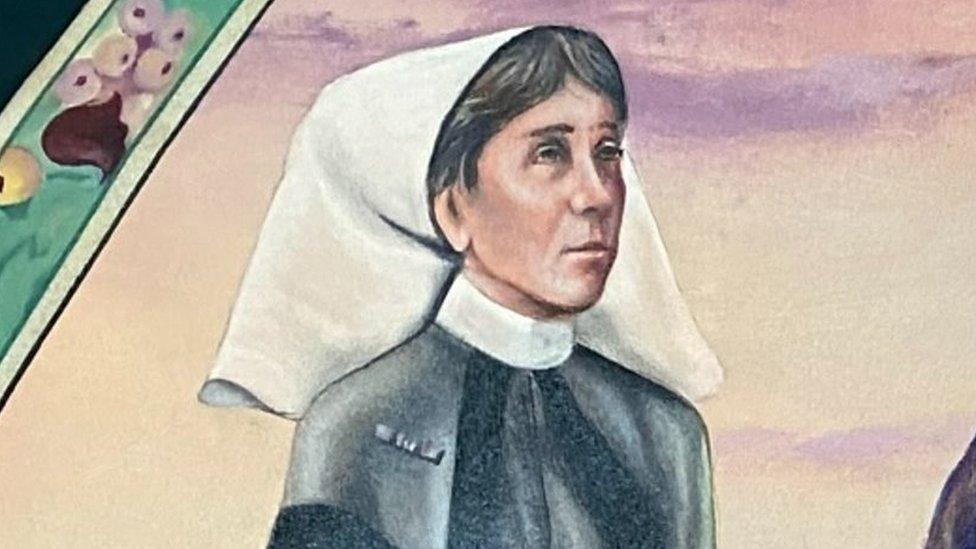
Kate Maxey was a nurse during World War One
Even as she lay with her body broken by a bomb blast, Kate Maxey's first concern was to keep her fellow nurses focussed on the wounded soldiers they were in France to care for.
"Miss Maxey's tact, zeal for work and influence for good are of the highest order," her commanding officer wrote in dispatches in the wake of the March 1918 explosion that nearly killed her.
Born a Spennymoor shop-keeper's daughter in 1876, she had always wanted to be a nurse and qualified in 1903.
In 1914 she and her fellow members of the Territorial Force Nurse Service were deployed to France where she gave "unstinting and distinguished service", the Durham Women's Banner Group said.
It was in Lillers where she became a casualty herself, when her station was caught in the blast from an ammunition train struck by a bomb.
She sustained multiple injuries to her head, neck, spine, arm and right leg and foot, but still "directed nurses, orderlies, and stretcher bearers, and refused aid until others were seen first," her officer wrote.
Her injuries ended her war despite her protests about wanting to return to the battlefield hospitals, but she recovered at home and went on to work in a nursing home in Halifax until her retirement in 1931.
For her wartime efforts, she was awarded a Royal Red Cross Medal First Class, Mons Ribbon, Military Medal and Florence Nightingale Medal.
She died in 1969 aged 93.
As well as being on the banner, a blue plaque celebrating her has been installed on her childhood home at Clyde Terrace in Spennymoor.
The banner group is meeting on 5 December, external to discuss future blue plaque nominations and all are welcome to join.

The strike supporter
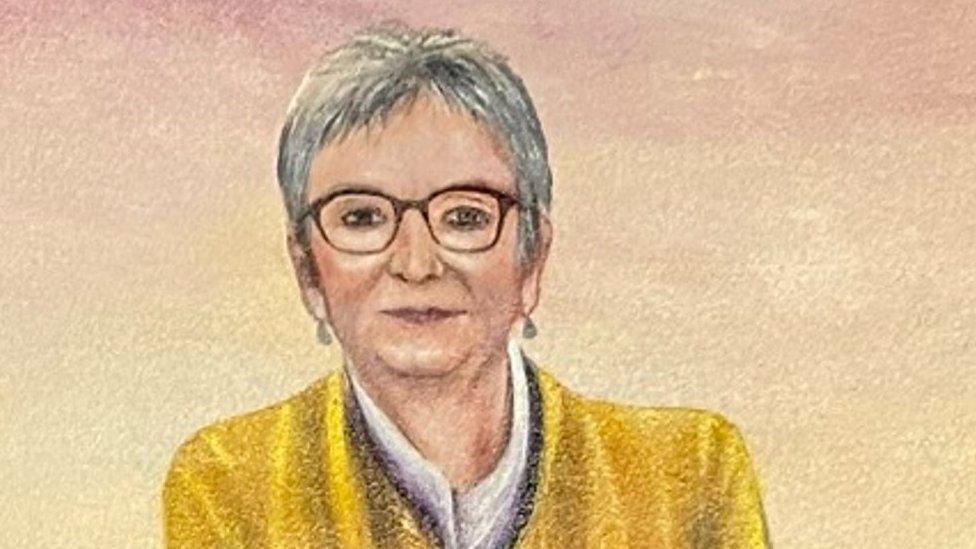
Heather Wood set up a network of support groups for women in County Durham
Heather Wood was 17 when she staged her first strike in 1968.
Unhappy with forced overtime and the lack of a union for her fellow office workers at Sunderland-based mail order firm Janet Frazer, she organised a walkout and made her first public speech - which led to the changes she was after.
She grew up a miner's daughter in Easington and went on to set up the Easington Colliery Women's Support Group which aimed to support miners' wives, the first of 14 such groups she formed in the area.
During the 1980s miners' strike Heather, joined others in running free cafes to feed mining families, nourishing up to 900 people a day.
Her group also arranged food parcels and raised funds for the miners, and worked with artists to help capture the mood and movement for posterity.
"Heather continues to be an inspiration to many working class women in the North East," the banner group said.

The anti-apartheid activist

Ruth First was an anti-apartheid campaigner in her native South Africa before working at Durham University
Ruth First was destined to be a campaigner, her parents having been founding members of the South Africa Communist Party after emigrating from Latvia in 1906.
Born in 1925 and brought up in Johannesburg, Ruth went on to study alongside Nelson Mandela at university before moving into politics.
She rose through the communist party during mine strikes and edited a radical, state-banned newspaper before being exiled to London in 1964 where she joined the British Anti-Apartheid Movement.
Ruth became a Durham University lecturer in the 1970s where her legacy remains with the The Ruth First Educational Trust, a scholarship that helps South African students study in the cathedral city.

The Aycliffe Angel
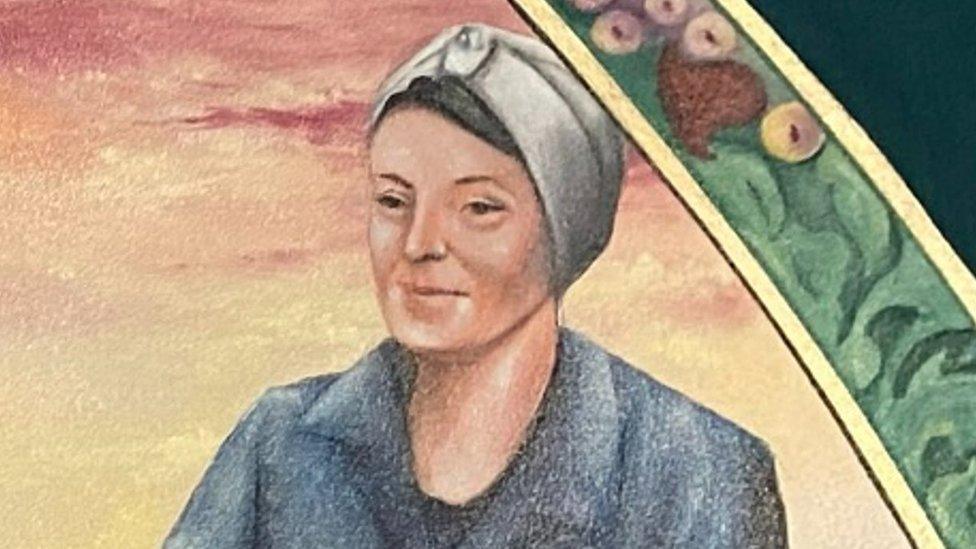
Some 17,000 women worked at the munitions works in Newton Aycliffe during World War Two earning the nickname Aycliffe Angels
One woman in the banner represents some 17,000 others.
Sporting her 1940s overalls and hair covering, she is the Aycliffe Angel, the name given to the thousands of women who worked at a munitions factory in Newton Aycliffe during World War Two.
Workers at the Royal Ordnance Factory on Heighington Lane filled shells and bullets and made detonators and fuses for bombs.
The workers got their nickname from the English-speaking Nazi propagandist Lord Haw-Haw who, in one of his infamous radio broadcasts, said the "little angels" would be bombed by the Luftwaffe.
It was dangerous work and many women were injured, some even killed, in industrial accidents.
"However, due to the secrecy surrounding the factory, many incidents went unrecorded and unreported and [the workers'] efforts went unrecognised," the banner group said.
The group unveiled a blue plaque at the factory site in October 2021.

The fire-starting suffragette
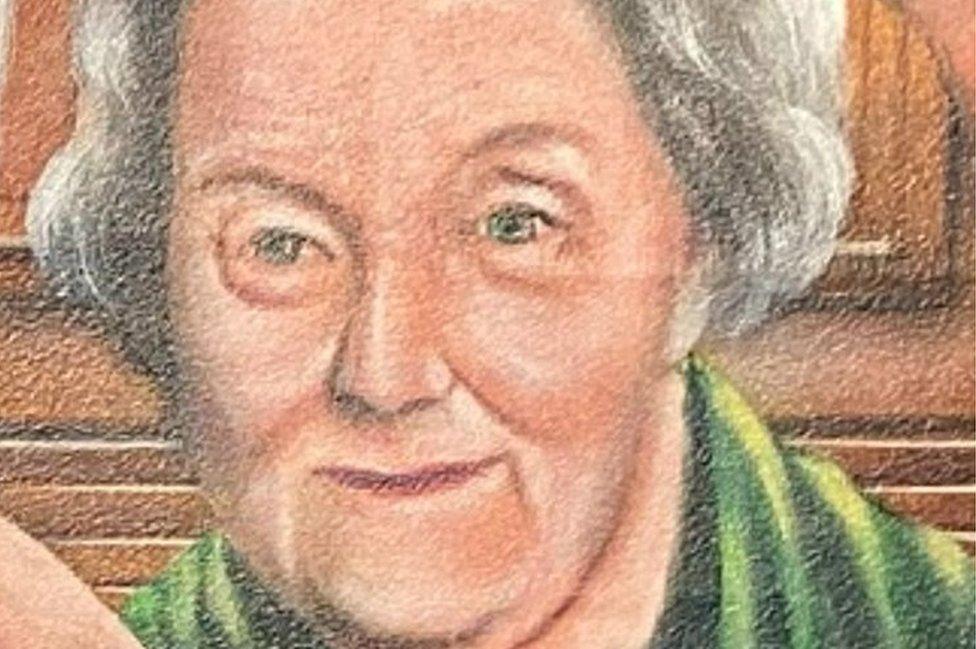
Connie Lewcock was a teacher and suffragette
Connie Lewcock committed in her words the "perfect crime" in aid of her cause.
Having failed in an attempt to start a fire at Durham Cathedral, the suffragette devised a device which could start a fire at a railway building in Esh Winning in what the Oxford Dictionary of National Biography, external called "the most notorious episode in her career".
In 1914, the then 20-year-old created a delayed incendiary device which was left at the railway by a co-conspirator while she attended a meeting several miles away.
It included some hairpins and a handkerchief bearing the letter C to point towards Connie, but her alibi meant the police could not prosecute her.
Her employers however offered her an ultimatum, cease all her political activities or lose her teaching job in Esh Winning.
She chose the latter, going on to rise through the Labour party and eventually represent the Benwell ward on Newcastle City Council between 1960 and 1971. She was appointed an OBE in 1966.
"She was an ardent suffragette, actively involved in meetings and activities throughout the county," the banner group said.

The people's champion
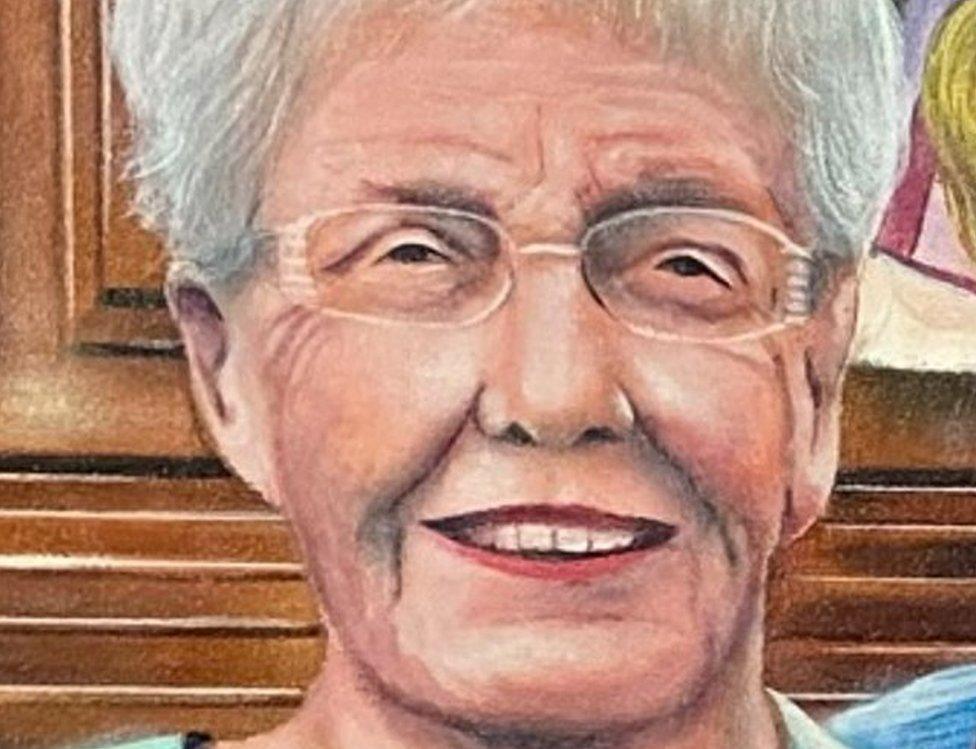
Myrtle MacPherson served on Easington Parish Council for more than 50 years
Myrtle MacPherson spent more than 50 years on Easington Parish Council where she "championed the needs of the people," the banner group said.
She worked in pit canteen serving miners' meals, which is where she met her lifelong partner Gordon, before becoming a school chef for the rest of her working life.
Shortly after her retirement, her community was hit by the miners' strike and Myrtle "played a pivotal role" in establishing free cafes for support the pit workers and their families.
She ran the kitchen, using one cooker and two boilers to prepare meals for hundreds of people a day.
Myrtle also led a delegation of women to Downing Street demanding the pits remain open, and spent a year in a caravan with fellow protesters outside the Vane Tempest pit in a bid to stop its closure.
"Myrtle won the hearts of many people," the banner group said, adding: "Her pies in particular were renowned."
She was awarded the Labour Party's Merit Award for Long Service in 2015.
"Myrtle was well-known for her honesty and plain-speaking, but most of all for being a strong woman who fought for fairness, justice and equality," the group said.

The lifelong pacifist

Pat McIntyre was a lifelong campaigner for peace and socialism
Pat McIntyre spent her life campaigning for peace and socialism.
She was a natural orator who won the Daily Herald's National Speaking Contest when she was 17 and used her voice to speak out about what she perceived to be the ills of the world.
She was a founder member of Peace Action Durham, a lifelong member of Ban the Bomb, campaigned against South Africa's apartheid and joined solidarity groups for the people of Vietnam, Nicaragua and Chile.
Closer to home, Pat co-ordinated support groups during the miners' strikes and in 1992 gained a PhD on Women and Labour during the protests.
"Pat's absolute honesty, integrity and humanity were always there for all to see," the banner group said, adding: "She became synonymous with the [socialism movement] and inspired many people to become active campaigners."
Laura Daly, founder of the banner group, said it was meeting Pat and then attending her funeral in 2018 that made her realise how little is recorded of Durham's "incredible" women.
"They were talking about all these amazing things she did, like going round the world to fight fascism, and I just thought 'Pat's is one of the many stories I felt we needed to tell'," Laura said.

The Everywoman

The woman with the megaphone represents every woman
The central figure bellowing through a megaphone may look like Laura, but she is quick to clarify it is not her.
"She is every woman," Laura said, adding: "The other members of banner group decided to model her on me which made me a cringe a bit but is very sweet, but it is not me."
Laura is very proud of the banner, but is disappointed it is yet to fulfil its purpose of featuring in the miner's gala parade, an annual celebration featuring thousands of people carrying banners and history through the streets of Durham.
It arrived three days before the first coronavirus lockdown and the two subsequent galas have been cancelled due to the pandemic.
"Women have always gone to the gala to support the men," Laura said, adding: "They are seen as a support, but the women kept the communities together.
"This banner is long overdue and women's achievements deserve to be recognised alongside those of the men."
She is hopeful the gala, first held in 1871, will return in 2022 but she has a contingency plan if not.
"We really hope it won't be cancelled again but, if it is, we will take the banner to the parade ground anyway and maybe just have a picnic."
More than 150 women were nominated to be included on the banner, with all of their stories to be told in a book being produced by the group.

Women of Labour

Annie Errington represents Durham Labour Women on the banner
Annie Errington represents all the women who have been party of Durham's Labour movement.
On 27 August 1926, she was part of the first party of British miner's wives to visit Russia in a trip organised by the Russian trade unions.
She returned home to Sacriston near Durham on 16 October having travelled thousands of miles to report back on the state of some of the world's fellow workers.

The 'nanna'

Everyone's Nanna depicts a woman with her granddaughter
The role and influence of people's grandmothers, or "nannas", is also featured on the banner.
"A recurring theme we noticed when receiving nominations of inspirational women were women voting for their nannas," Laura said.
"So many of us had strong and inspirational nannas that we felt everyone's should be depicted on the banner."
A young girl is also included, the next generation to be shaped by her grandmother.

The causes
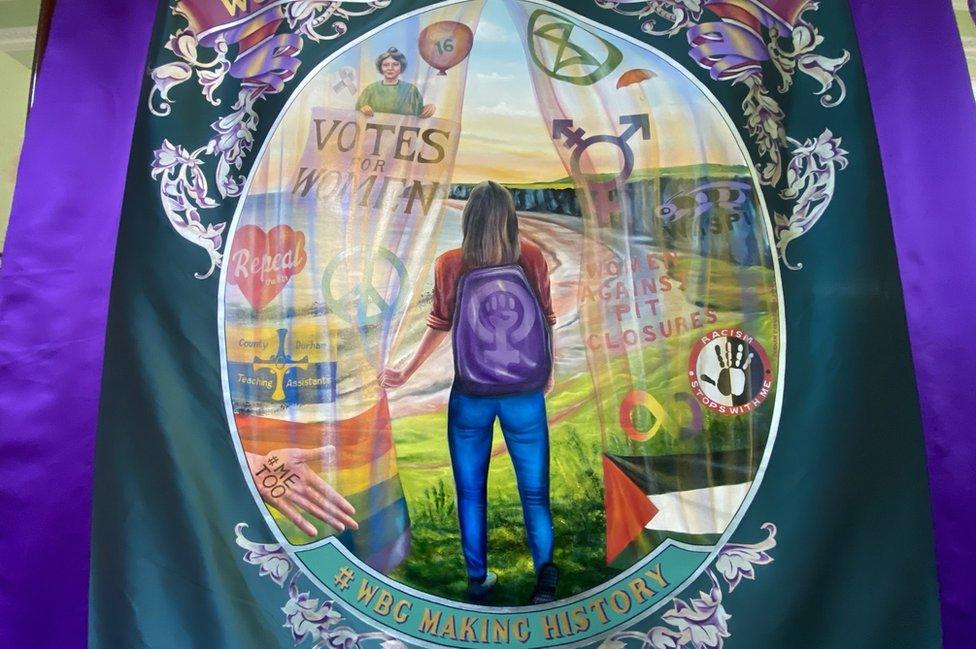
The other side of the banner shows some of the various causes the women of Durham have supported over the generations
The other side of the banner features a young woman pulling aside the veils of history.
The curtains are adorned with some of the causes the women of Durham have fought for over the generations.
These include Votes For Women, nuclear disarmament, Me Too and anti-racism and LGBT rights campaigns.
"We would love people in the future to look at these causes and wonder why they were ever even an issue," Laura said, adding: "That's the future we will fight for on the backs of the amazing women who have done so much before."

Follow BBC North East & Cumbria on Twitter, external, Facebook, external and Instagram, external. Send your story ideas to northeastandcumbria@bbc.co.uk, external.